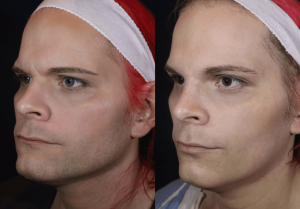Dr. Jennifer MacGregor is a member of the World Professional Association for Transgender Health and is recognized by the Huffington Post as a top dermatologist to the transgender community. She has published important research in the space and caters to a wide patient base of LGBTQIA+ cosmetic dermatology patients. In 2019, ALLURE Magazine featured her in a piece “Jennifer MacGregor Wants to Make Dermatology a Better Experience for Trans Patients.”
Transgender people were born with anatomy that doesn’t align with their identity and physical vision for themselves. All people benefit from presenting themselves in the most healthy and best way possible — when their outer appearance matches with how they feel on the inside — and non-invasive aesthetic treatments can help support that transition and enhance confidence.

Below is a Q&A with Dr. MacGregor:
What’s different about transgender dermatology treatments?
Medications (typically hormones) used for gender transition and surgical procedures can present unique challenges. Testosterone can cause acne, which must be treated, and while male-to-female transition can thin facial hair, laser hair removal is typically desired to achieve the smoothest skin possible. Scars, dry skin, rashes, and other issues also crop up along the way and must be treated by a well-trained board-certified dermatologist.
Transgender or not, it’s our responsibility to create a safe space where our patients’ needs are met and the focus is on that individual’s particular goals.
What are the similarities?
General skin issues affect all people regardless of gender and all people need great dermatologic care!
Many individuals also pursue non-invasive aesthetic procedures with the aim of presenting their best possible selves to the world. All people want to feel comfortable in their own skin and feel that their image is a healthy reflection of what’s on the inside. All people have their own unique anatomy, attributes, gifts, strengths and weaknesses, and everyone has their own unique ideas about inner and outer beauty and goals to present their best selves.
As physicians and providers, our responsibility is to listen to our patients, create a safe and friendly space so they can teach us, and then strive to provide the best possible outcome.
What treatments are popular among transgender patients?
Facial injectables are popular since they’re not painful, require little recovery time, and can be tailored to make features appear more masculine or more feminine, according to an individual’s goals. Laser hair removal, laser resurfacing for acne and surgical scars, and non-invasive body contouring for troublesome fat pockets and smoother skin are also popular among people of all genders and age groups.
What about facial hair?
One thing I’ve learned from all of my patients is never to assume what they want, what they see in the mirror, or what their goals might be. I simply ask what pronoun they prefer, what facial and body hair patterns they prefer, and what they wish to accentuate, minimize, etc. Gender doesn’t define these things. It’s up to the individual’s preferences and goals for their own appearance.
For example, people that identify as male (both trans and cisgender) may prefer to remove beard hair or achieve a softer arch to the brow, while people who identify as women prefer a stronger jawline or a flat/stronger brow. Gender alone doesn’t form an individual’s concept of beauty. Cultural background and perceptions also play a major role.
Does facial hair affect the skin?
Female-to-male transitions can result in new acne, facial and body hair growth, ingrown hairs, and folliculitis. These are all easy to treat in the office with laser, topical medications, and short courses of oral antibiotics for severe cases. A patient with severe acne may also consider isotreinoin (Accutane) to prevent scarring.
What should a transgender patient look for in a dermatologist?
Firstly, seek a board-certified dermatologist. Transgender patients have a high rate of complications from aesthetic procedures because they seek care from unlicensed or untrained providers that have specifically advertised to them.
Secondly, look for real patient testimonials and before-and-after photos. Photos, in particular, give visual examples of what you can expect from aesthetic procedures. Surgeons specializing in gender reassignment have been doing a better job of this recently, but we have a great need in dermatology for more before-and-after photos of transgender individuals who have had non-invasive or minimally invasive aesthetic procedures.
Closing the practice gap
I’ve recently been told that many individuals feel uncomfortable seeking care from a provider that hasn’t specifically reached out to the community. I guess I’m not surprised to hear that, but I wish I thought more about this practice gap before now. There is already a history of criticism, judgment, and more of a daily struggle just to be an authentic version of themselves. By creating more public messaging, reaching out to the community, and establishing a better repertoire of before-and-after images, we can make people more comfortable coming to us for treatment.



